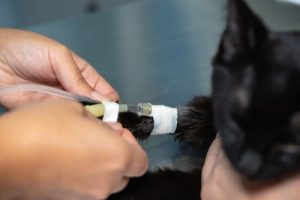Sedation is used in cats to help them relax, both physically and mentally. There are several reasons why vets use sedation, such as for minor procedures, to help cats with behavioural difficulties and before a general anaesthetic to make your cat sleepy.
There are many options available for sedation in cats. Your vet will work out what is best for your cat based on their age, breed, behaviour and if they have any health conditions. Sedation is different from a general anaesthetic, as they are not fully asleep. Sedation can be used safely for cats of all ages and sizes.
What it’s for
What is sedation used for in cats?
Sedation is used for the following reasons in cats:
- To help them relax for minor procedures, such as cleaning abscesses, doing an x-ray or ultrasound, a thorough ear exam and taking a fine needle aspirate of a lump.
- For both short and long-term anxiety and stress, such as vet visits, grooming, and firework phobias.
- Before general anaesthesia to help reduce the amount of anaesthetic used and smooth the induction and recovery phases.
Common drugs that are used for sedation in cats
Vets use one or more of the following drugs for sedation, usually in combination for better effects:
- Opioids: methadone, buprenorphine, butorphanol
- Alpha 2 agonists: medetomidine, dexmedetomidine
- Benzodiazepines : diazepam, midazolam
- ACP / acepromazine
- Ketamine
Sedation drugs commonly used for anxiety include gabapentin, trazadone, diazepam, and alprazolam.
How it’s done
How are cats sedated?
The following steps show what to expect if your cat needs to be sedated:
- Your cat is brought into the practice as an inpatient, usually first thing in the morning.
- They are given a comfortable kennel for the day.
- When it is time for their procedure, your vet will inject your cat with sedation medication, either under the skin, in the muscle, or in the vein.
- The procedure then takes place. Throughout the procedure, your cat is usually monitored carefully by a qualified nurse to check their heart rate, breathing rate and other vital functions. Sedation may need topped up, if the procedure takes longer than expected.
- Your cat may be given a reversal agent. They are then monitored until they are safe to go home.

How to prepare your cat for sedation
Your vet will usually advise starving your cat from the night before sedation. Keep your cat indoors the night before to avoid them eating something outdoors or any delays in finding them.
Make a note of any abnormal signs your cat has or any medication they are currently taking to bring to your admission appointment.
If your cat is already nervous for vet visits, then they may be given some anti-anxiety medication the night before to help them relax. Spraying their basket with a pheromone spray can help reduce stress. Make sure to use a secure basket to bring your cat to the vet.
Costs
How much does it cost to have your cat sedated?
The costs of sedation can vary widely depending on where you live, how much your cat weighs, if they are anxious, and how long the procedure lasts.
- Costs usually include the drugs used for sedation and reversal, continuous monitoring, and equipment used, such as catheters and syringes.
- Specialist hospitals and referral centres usually cost more than first opinion practices as they perform more complex procedures.
- A rough estimate for sedation alone is usually around £70-150
Risks
Is sedation safe in cats?
Sedation is generally considered low-risk for cats; complications can happen but are not common. The medications used for sedation in cats come with risks due to changes in the blood pressure, body temperature, heart rate and breathing rate. Your vet will take your cat’s age, breed, and any health issues into consideration when calculating their medication for sedation to minimise risks.
A pre-operative blood test is advised to check for abnormalities in organs such as the kidneys and liver. If possible, this is a good idea no matter what age your cat is.
Factors needing increased care for sedation:
- Age: very young or elderly
- Immunocompromised or unwell cats
- Overweight cats
- Breed: Himalayan (thought to be due to BOAS)
Recovery tips
How to help your cat after sedation
Your cat will usually recover much more quickly after sedation than an anaesthetic. They may be more sleepy and less hungry but they should usually be back to their normal selves within 24-48 hours.
- Make sure they have a comfortable and quiet area to rest and sleep
- Your vet will usually advise a smaller meal than normal when they get home after the sedation
- Your vet may recommend keeping them indoors for a few days (may be longer, depending on the procedure)
- Give any medications as advised by your vet
When to worry
When to worry about sedation in cats
Seek help from a vet if your cat:
- Has breathing problems after sedation
- Is in pain after sedation
- Is hard to wake-up
Call us and speak to one of our Joii vets if:
- You have any concerns about sedation in cats
- You have questions about your cats behaviour








